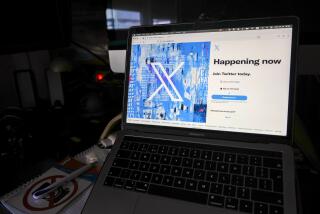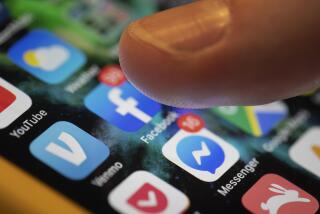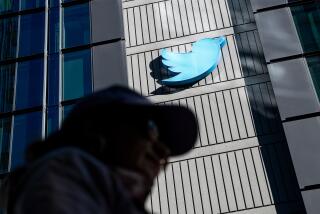Op-Ed: Mining Twitter gold, at five bucks a pop
- Share via
Not to brag or anything, but I probably have more Twitter followers than you.
I wish I could say I earned them all with my erudite tweets. The truth is, I purchased many of them.
A couple of months ago I ran an experiment to see how easy it would be to up my online profile. As a data scientist, I was intrigued by the notion that not all followers are earned: There is a lively Internet business in selling followers — specially created fake accounts on Twitter or other social networking sites that were set up by enterprising businesspeople specifically to bump up follower numbers for people willing to pay.
I was curious to see what I could measure from this process. Would purchasing followers prove to be totally worthless? Or would having more acolytes — even fake ones — actually affect my life online?
As social beings, we’re programmed to compare ourselves to others, and social network spaces are filled with metrics, measurements and scores that give us the ability to easily see how we measure up. But what the numbers mean isn’t always clear. Twitter users with tens of millions of followers are usually people as famous offline as they are online. But what about those with hundreds of thousands of followers? Tens of thousands? Just a few hundred?
At the start of my experiment, I used Twitter’s API to get a list of my 2,600 Twitter followers. Then I set about figuring out where to buy more.
Google conveniently auto-completed my search for “buy Twitter” with a number of useful suggestions, including: “buy Twitter followers,” “buy Twitter followers cheap” and “buy Twitter followers reviews.” I was certainly not the only one searching for this.
It was a tough choice, but I finally settled on buying 4,000 followers from a seller I found on fiverr.com, an online marketplace for services that cost $5 or less. I specified my Twitter handle — @gilgul — paid my five bucks and waited.
Within 24 hours, my profile had jumped, as promised. Instead of having about 2,600 followers, I was now in the 6,600 range. I remember the rush I got as I saw notifications fly by alerting me to more and more users who were following me. Even though I knew that none of them had any interest in me or my tweets, I was still thrilled. Sixty-six hundred followers!
Once my 4,000 purchased followers were onboard, I used the Twitter API to make another grab of my followers list, which I compared with my earlier list to create a list of the 4,000 fake Twitter accounts following me. This was exciting stuff. In my line of work, having access to such a clean data set is not easy to come by.
Using the data, I began looking more closely at my new followers. It was not immediately clear from glancing at their profiles that they were just bots. They all had profile images and screen names that didn’t necessarily feel automated. But looking more deeply, it was clear that something was off about their profiles. The bios included random snippets of text from what I suspected was a book or manuscript. Additionally, the majority of my new fans were following vastly more users than they had users following them.
Now for the exciting part. Using my list of bots, I began to map out who else my new followers followed, hoping to shed light on what kinds of folks purchase followers. In the aggregate list of hundreds of thousands of accounts that my bots followed, I found DJs, musicians, fashion designers, comedians, politicians, real estate services, banks, marketers and brands.
It made sense, I suppose. How exciting is a musician with few fans on Twitter? How credible is a politician whose tweets nobody signs up to receive? On social media, it is easy to mistake followers for credibility, which is why so many people seem to be paying to add them.
Ultimately, I identified hundreds of thousands of accounts that had some fake followers. Of course, that doesn’t necessarily mean the owner of the account purchased them. I could have easily purchased followers for another Twitter user. A publicist could purchase them for a client, say, or just some random fan. But what was clear is that the number of Twitter users with fake followers is massive.
Even more interesting, at least to me, was what my fake followers did for me. My Klout score almost instantly shot up. I was not impressed by that until I realized that Microsoft’s search engine, Bing, collaborates with Klout, so that a higher Klout score put me higher on Bing’s search results. My completely fake numbers on one platform had a very real effect on a completely different service.
Over time, I also started seeing an increase in the number of my actual followers. This could be because Twitter started pushing out more notifications to its users. It could also be a factor of perceived credibility. When a stranger viewed my profile, my large number of followers made me look more credible.
After a few months, some of my fake followers began disappearing. But my total number of followers has continued to grow. In a way, what I did was effectively optimize my social media account. Perhaps acquiring that chunk of followers gave me enough of a bump to start feeding organic growth.
I’m not recommending anyone go out and buy followers. In fact, I can’t get over the feeling that it’s pretty sleazy. But I do have nearly 12,000 Twitter followers. Do you?
Feel free to head on over to Twitter and follow me: @gilgul
Gilad Lotan is chief data scientist at Betaworks.
More to Read
A cure for the common opinion
Get thought-provoking perspectives with our weekly newsletter.
You may occasionally receive promotional content from the Los Angeles Times.










